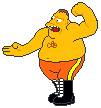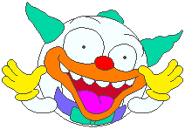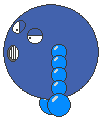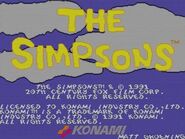The Simpsons arcade game was produced by Konami in 1991. It was released in North America on March 12 and in Japan on August. The game began development in February 1990 and underwent location testing in the Chicago, Illinois area (where the Konami's U.S. subsidiary was located) in December of the same year, a few months before its full release. The Japanese game developer had prior success with the 4-player Teenage Mutant Ninja Turtles arcade game and attempted to reproduce the same success with a game based on The Simpsons.
Conversions of the game were released for MS-DOS and Commodore 64 in 1991, both developed by Novotrade. Backbone Entertainment would later released an emulated version for the Xbox 360 and PlayStation 3 on February 2012 as a digital download. However, Konami only reacquired the license temporarily and the digital versions on both platforms were discontinued in 2014.
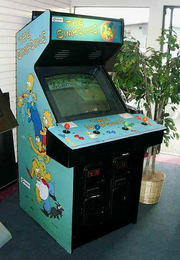
The Simpsons: The Arcade Game
Plot
The Simpsons are walking in the street when Smithers, who stole a diamond from a Jewel Shop for Mr. Burns, accidentally bumps into Homer. This sends the diamond flying and landing in Maggie's mouth. Smithers kidnaps Maggie and runs off with the diamond in her mouth, prompting the Simpsons to pursue him and attempt to rescue Maggie. On the way, they encounter goons hired by Mr. Burns to stop the family from getting Maggie back and are forced to fight them. After defeating several goons including a wrestler, they chase Smithers into Krustyland, where they are attacked by Clowns and rabbits (from Matt Groening's original cartoon Life in Hell). They corner Smithers on a Krusty balloon but the balloon pops, sending the family and Smithers falling down to Springfield Cemetery (Shorts). Zombies, awakened by Mr. Burns, rise from their graves and attack the Simpsons family, but the family fights them off. The Simpsons family then follows Smithers into Moe's Tavern, where they encounter several mobsters and a Drunk which they are forced to fight. The Simpsons later follow Smithers to the Springfield Butte. Smithers is fleeing from a bear and carries Maggie towards a river, and the Simpsons follow his trail, battling woodsmen and apes on he way. The bear that was chasing Smithers tries to kill the Simpsons, but the family defeats the bear. Smithers escapes by helicopter and the Simpsons family are sent down a large waterfall and are knocked out. In their coma, the Simpsons envision themselves in the clouds and in their minds they battle a gigantic bowling ball. After waking up, they see the helicopter landing on top of the Channel 6 studio. They get in the studio and see Scott Christian doing a news report on Maggie's kidnapping. They have a brief battle with a Japanese Kabuki Warrior before hopping on a helicopter to the Springfield Power Plant, where Smithers has taken Maggie.
At the Power Plant, the Simpsons family confront Smithers, who battles them with bombs.When Smithers is defeated, Mr. Burns breaks through the wall inside a large machine which attacks with Bombs, Lasers, Missiles and Pincers, and starts a climatic battle against the Simpsons. After a long fight, Burns is defeated, and the Simpsons rescue Maggie, who places her pacifier into Mr. Burns' mouth. They celebrate along with Grampa, Patty and Selma. In the end, Homer throws the diamond away and Maggie puts her pacifier back into her mouth.
Gameplay
The player chooses from one of the four Simpsons family members: Homer, who punches and kicks; Marge, who swings her vacuum cleaner; Bart, who wields his skateboard; and Lisa, who uses a jump rope like a whip. The game's levels are based on various locations from Springfield, including Downtown, Krusty Land, the Graveyard, Moe's Tavern, Springfield Butte, a Dreamland, the Channel 6 studio and the Springfield Nuclear Power Plant Power P. Each level ends with a boss whose speed and strength would increase after taking a set amount of damage. Although the game is one of many beat 'em ups produced after Final Fight, it contained many innovations, including the option for two players to team up and attack enemies, with the exact attack differing slightly depending on which two characters were being used. Food could be used for healing, and various weapons and items could be obtained for use for a short time or for a one-time projectile attack. These items were often brought into the game by other Simpsons characters, and the Simpsons' own pets could be used as thrown weapons at various points in the game. The Japanese version of the game included small scale nuclear bombs that, when thrown, clear all on-screen enemies, as well as a life bar that can be doubled by eating food when your character's health was full. The main characters retained their voice actors from the show. The game features two minigames in which players competed against each other to be the first to finish a task (inflating a balloon shaped like their character in the first game, waking up their character in the second). The minigame was based on repeated button-pushing, with the player who pushed the buttons fastest winning. If fewer than four players were present, the player or players competed against 1-3 computer-controlled characters in these minigames. During the game if the player does not press any buttons the selected character will break the fourth wall except Homer who only yawns. Marge swings her hair and says "How's my hair?", Bart looks at the player with a confused look on his face saying "Who the hell are you?" and Lisa sticks her tongue out and making a face at the player taunting "Ha ha made you look!". The game featured many strange enemies, ranging from the infamous men in the purple suits, to battles with Bongo-like rabbits. The game included battling fat, old men; miniboss-like firemen; and even giant donuts. One of the visual gags in the game include Marge showing rabbit ears similar to the Life in hell rabbits, like her skeletal silhouette when electrocuted. According to several DVD commentaries, before The Simpsons became a full series, Marge was going to have rabbit ears under her hair and reveal them in the last episode.
Voices
- Dan Castellaneta as Homer
- Julie Kavner as Marge
- Nancy Cartwright as Bart
- Yeardley Smith as Lisa
Levels
- Downtown
- Krustyland
- Cemetery
- Moe's Tavern
- Springfield Butte (Springfield National Forest)
- Dreamland
- Channel 6 Station
- Springfield Nuclear Power Plant
Bonus Stages
- Blow up your balloon
- Wake up
Enemies
- Goons
- Fat Goons
- Door Women
- Fire Fighters
- Krusty Look-a-likes
- Rabbits
- Zombies
- Barrel Women
- Bigfoot
- Loggers
- Donuts
- Marge Clouds
- Power Plant Employees
- Saxophones
- Bart Devils
- Ninjas
Bosses
- Professor Werner von Brawn
- Krusty Balloon
- Mobsters
- Drunk Man
- Bear
- Bowling Ball
- Robot
- Kabuki Warrior
- Waylon Smithers
- Mr. Burns
Gallery
Enemies
Bosses
Videos

Walkthrough
Screenshots
Trivia
- This was the first Simpsons game ever made.
- Smithers has his design from There's No Disgrace Like Home.
- Hank Azaria and Harry Shearer didn't do voices for the characters of the game.
- One of the visual gags in the game include Marge showing rabbit ears similar to the Life in hell rabbits, It happens when her skeletal silhouette when it she gets electrocuted, and during her melee as her vacuum tries to suck up her hair. This is a reference to Matt Groening's initial design of the character Marge Simpson. Groening originally wanted Marge's hair to conceal rabbit ears, and have them finally exposed in the last episode, but this was soon scrapped.
- When the tall mobster says Where do you think your going, Mr. Burns says that every time he changes his way of movement from the legs to the tank treads to the hovercraft.
- The mobsters make brief appearances in Downtown Springfield and Krustyland, where they spy on the Simpsons.
- Smithers' laugh is actually heard from every single enemy or boss when they laugh.
- When Maggie puts the pacifier in Mr. Burns mouth, the next scene shows that the diamond disappears and then goes back in Maggie's mouth, but the diamond is supposed to be in her mouth.
- When any of the characters talk, their mouths don't move.
- Smithers and the mobsters have the same theme music.
- The bear boss appeared in stage 2 when it escaped from Krusty Land and went to the Butte for its new home.
- The rabbit enemies are from the comics Life in Hell.
- In the Arcade version, there are two robots in the Channel 6 stage. However in the DOS version, there is one robot.
- The bigfoot enemy is based on Homer when he was mistaken for Bigfoot in the episode "The Call of the Simpsons."
- The Bowling Ball boss, makes the same sound as the wrestler.
- The wrestler is actually Professor Werner von Brawn from "Bart the Daredevil."
- In Moe's, copies of The Simpsons arcade cabinets are seen in the background. These cabinets are depicted differently than the final version. Next to it is a copy of the game Aliens. Another arcade game produced by Konami at the time. That game's attract screen features Marge as a Xenomorph who scares off a creature from Space Mutants (a recurring film series on the show).
- Princess Kashmir, the lead dancer from "Homer's Night Out" appear on stage at Moe's dancing to music performed by Bleeding Gums Murphy. If Homer stands next to the stage he'll start to do his victory dance.
- Selma and Patty appear at both the beginning and in of the game. However Patty's sprite is simply a pallet swap of Selma's.
- Upon rising from the ground at the cemetery level, the zombies do a quick dance. This can be considered a nod to Michael Jackson's Thriller.
- Kent Brockman does not appear in the Channel 6 level. Rather a nameless anchor appears in his place.
- The game's music was composed by Norio Hanzawa. Most of the game's score was included in the compilation soundtrack album Konami All-Stars 1993: Music Station of Dreams (KICA-9016~8) exclusively in Japan. The music can be found on tracks 37-41 of disc three.
- Halfway through the Springfield Butte stage, Sideshow Bob can be seen with a turkey food item. Ironically, he is considered an ally despite being seen on the show framing Krusty the Clown for robbing the Kwik-E-Mart in the episode Krusty Gets Busted which premiered in April of 1990.
- This is one of the few beat 'em up games of the franchise. Inspired by Capcom's Final Fight released in 1989.
- The Couch Gag during the attract scene is similar to that used in Moaning Lisa.





